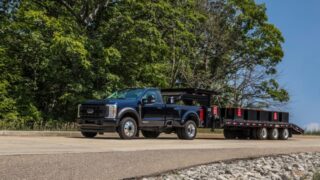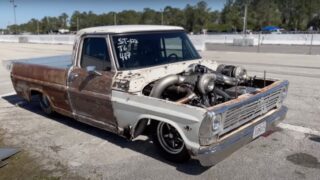D.I.Y.: Flushing Your Ford Truck Brake Fluid
Lots of Ford owners change their engine oil and transmission fluid, but they neglect the braking system.
The odds are good that if you work on your Ford truck, you have changed your engine oil and transmission fluid. Others have also flushed their coolant system, as these are all common projects for do-it-yourselfers to tackle at home, but it seems that many people don’t think about their brake fluid. In much the same way that your engine oil, transmission fluid and coolant gets dirty, the fluid that drives your brakes also gets dirty over time, so like the other fluids in your Ford truck, brake fluid needs to be changed from time to time as well.
One of the key reasons that many people might avoid changing their brake fluid is that it isn’t as simple as just draining it and refilling it. Fortunately, this great write-up by “Fat Diesel” shows that changing your brake fluid is almost as easy as changing your engine oil.
Brake Fluid Changing Methods
There are two basic ways to change the brake fluid in your Ford truck or any other vehicle that uses a modern hydraulic setup. You can force pressure from the master cylinder, down through the system to the calipers or you can attach a tool to each caliper and pull the fluid through the system. Both methods achieve the same basic result, but going from the top-down helps to free up junk throughout the entire system.
The Simple Process
When the OP began his thread, he offered simple step-by-step instructions of how he flushed the brake fluid in his Ford truck.
I got the power bleeder out and had the fluid flushed in no time.
Here is what I started with. I use the Blue and Amber versions of the same fluid so I know exactly when the fluid is flushed out.
That power bleeder is used to force the fluid from the top-down and through the bleeder screws in the brake calipers. He began by using the power bleeder to force air into the master cylinder, which pushed the old fluid into the brake lines.
Hook up the bleeder and pump some air in it. I flushed all the old fluid in the master cylinder through because my mity vac has a hose that won’t easily fit into the reservoir.
Once the system was pressurized a bit, the OP hooked up a rubber hose to the bleeder screw on one of his calipers, putting the other end in an empty jug to catch the old fluid. Once he opened that bleeder screw, he continued to force out the old fluid until there is enough room to begin adding the new fluid.
The new fluid pumps in just like the air and the OP simply pumped it through that one caliper until the fluid changed color, but in the situation where you are using the same color of fluid, you will pump until it runs clean.
Once he had clean fluid draining from the bleeder screw, that wheel was done so he tightened up the bleeder screw and moved onto the next wheel. For the next week, it is was as simple as hooking up the hose to the bleeder screw and beginning to pump the new fluid through the system.
Key Notes
In addition to the instructions from the OP, other members shared input that can make a brake fluid change easier and more effective.
Forum member “jtharvey” offered the following input on the project as a whole:
Good pics there FD. And I definitely like using the different fluid colors. Smart idea there.
One tip to anyone who is getting ready to flush & bleed their brake system, it’s recommended to start with the caliper farthest away from the master cylinder then work your way to the one closest to it. Something that I’ve used successfully on my motorcycles for years, and now on my PSD are Speed Bleeders. They are bleed screws that replace your stock ones. Simple to put in place, unscrew and remove old ones, screw new ones in. The unique thing about them is they have a 1-way check ball in them that will let old fluid and air out, but nothing back in. You just have to open the bleeder valve a bit, attach a hose to the end of it, then get in your truck and pump the brake pedal until the fluid is clear again. If I remember, they are less than $10 for a set of 2 at O’reilly’s.
Just presenting another option for one man bleeding. Which I would recommend to anyone to do. I didn’t realize how bad my fluid was until I flushed it out. It was the color of used oil.
While “Kwikkordead” added the following input:
And to add to this: Brake fluid needs to be flushed every two years, regardless of mileage. It sucks water right out of the atmosphere and it gets diluted, even if you never remove the filler cap, which lowers the boiling point of the brake fluid. That will increase the potential for brake fade.
The thread continues on with questions from members experiencing braking issues, but for anyone who likes to do their own maintenance, this thread shows just how easy it is to change one of the vital fluids in your Ford truck.







